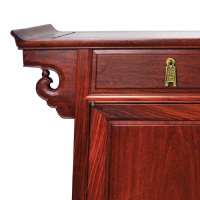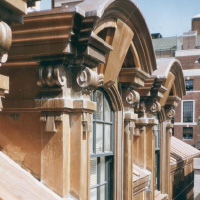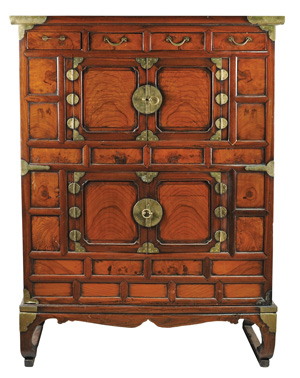
Korean Clothes Press composed of four doors with four drawers across the top; original decorative brass hardware. Made of zelkova wood, native to Korea, Japan, and parts of Eastern China, ca. 1890s-1920s.
We all have memories of the pandemic. None may be as unusual as those of Susan Fisher, owner of Asian Influences in Lawrenceville: “The pandemic forced people to stay home. When it was over they were sick of the furniture they had been seeing for two years and wanted to enjoy a new look with beautiful, classic pieces. So they came to me.”
Beautiful and classic describe the Chinese, Japanese, and Korean solid, sometimes rare, wooden furniture from the 18th through 20th centuries that can be found at Asian Influences. Think mahogany and rosewood, fitted so perfectly that nails are not needed.
Another aspect of the pandemic is that working at home became necessary, acceptable, even preferred. Not only did workers need a visual change but also one that was conducive to a home office. Fisher sold every piece in her store after the pandemic and had to buy more, which was fortunate because, she says, “people also wanted to sell things they had grown tired of looking at. Sometimes it is a family piece that grandma had, then mom, then the person selling it; they just didn’t want it anymore and neither do the kids.”
Fortunately, Chinese furniture has a universal appeal. “The simplicity of line of Chinese furniture has been that way since they started making furniture. These pieces almost seem to have been made to blend with European furniture, including modern, because there’s not a lot of fussy styling. The objects will not detract from the look of modern furniture or any other style,” states Fisher.
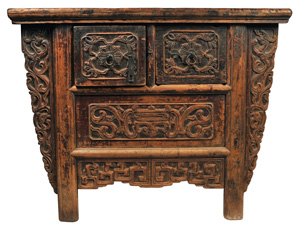
Chinese Coffee Table with three drawers having carved fronts detailing dragons and florals; carvings repeated on side embellishments. Made of elmwood, from the Shanxi province, ca. late 1700s.
Chinese design has had great influence on several Asian countries. In furniture it can be seen in the same simple classic lines noted above, but with national differences. The Japanese step tansu, such as the one shown on page 32, was built for several purposes—to function as a portable chest, to even be used as stairs. “The Japanese had limited space, so their furniture was also utilitarian by necessity,” explains Fisher. A third purpose is that the top can be flipped over to perfectly fit on the bottom portion to create a flat surface.
Much of the furniture now available was shipped out of China by the Chinese themselves because of the pressures brought on by Mao’s cultural revolutions. The pieces were sent to northern China, across Russia, into Europe, then to markets worldwide.
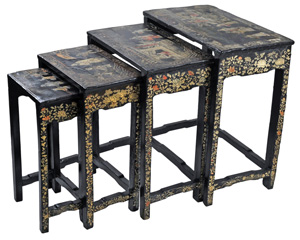
Chinoiserie: English(?) Nesting Tables hand painted with figural panels on each top surface and
decorative floral designs on the legs and aprons.
Unknown wood, ca. mid-1800s.
Fisher buys from an importer in Kentucky whose warehouse is chockfull of mostly northern China and Mongolian work from the late 1800s on as well as early 20th-century Korean pieces. But sometimes there can be surprises.
“I recently went to Kentucky on a buying trip with my family,” she relates. “There, Michael was very anxious to show me pieces he hadn’t shown other people before, and I was fortunate to have had that opportunity. I purchased a chest from the 1700s (Chinese coffee table, above). He was actually reluctant to sell it, but I talked him into it. It’s the most solid piece you can imagine, with beautiful carving.”
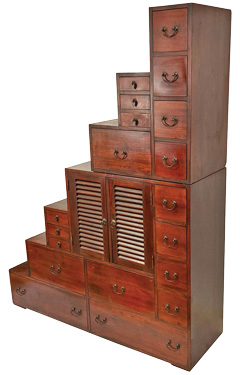
Japanese Step Tansu composed of two sections having 19 drawers and two doors. The top half can be flipped to rest on the base, creating a flat surface. Originally used as steps to access a loft area. Probably cypress, ca. 1950s.
Fisher gets furniture from such sources as reinvigorated stay-at-homes and dealers, often from out of the blue. Some pieces came from Texas via a man in Maryland, who brought them there after his sister died. The items not having been sold in that state, he contacted Fisher. In another instance, a woman had to sell pieces that filled her late sister’s farmhouse here in Eighty Four. That woman had traveled extensively in China, including as an attaché in Nixon’s entourage when he went over in 1972.
“I don’t know how these people find me,” Fisher muses, “but I have been very fortunate. I get the pick of beautiful things without traveling. It’s a joy—it’s like Christmas! I sell furniture that I personally select. When I see something that speaks to me, bells ring and I say wow. There is a personal connection. It’s astounding what people part with.”
Fortunately for those who are looking for the best, all those now-unwanted castoffs become desirable treasures for the discerning customers at Asian Influences.



